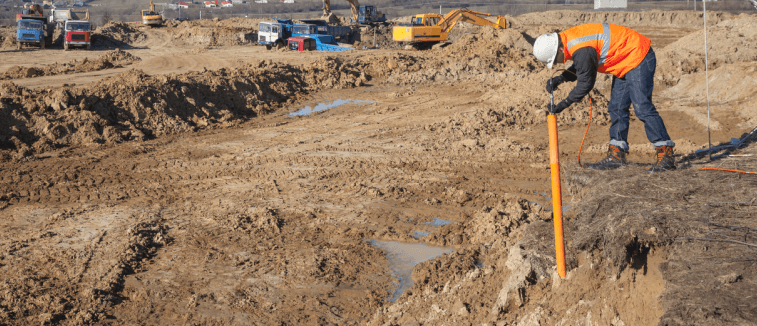Tailings Engineer: Crucial Knowledge for Sustainable Waste Administration in Mining
Tailings Engineer: Crucial Knowledge for Sustainable Waste Administration in Mining
Blog Article
Discovering the Ingenious Strategies and Technologies Shaping the Future of the Geotechnical Sector for Lasting Engineering Solutions
The geotechnical market is undertaking a transformative shift, driven by innovative methods and technologies that emphasize lasting design remedies. Advanced dirt stabilization approaches, making use of wise products, and the application of information analytics are redefining how we come close to facilities difficulties. As these developments promote environmental stewardship, they also raise critical questions about their practical application and lasting efficiency. Comprehending the interplay between these innovations and their possible to change the area invites more expedition right into the future of sustainable engineering methods.
Advanced Soil Stabilization Strategies
Soil stabilization is a vital procedure in geotechnical design, targeted at enhancing the physical properties of dirt to enhance its load-bearing ability and durability. Advanced soil stabilization methods play an essential function in addressing difficulties related to weak or unstable dirts, thereby enabling secure and reliable building and construction practices.
Among the famous methods, chemical stabilization entails using additives such as lime, concrete, or fly ash, which respond with dirt bits to develop an extra natural mass. This technique is especially reliable in boosting the strength and moisture resistance of extensive clay soils. Mechanical stabilization, on the various other hand, entails the physical modification of dirt residential or commercial properties with compaction or the unification of granular products, bring about enhanced density and stability.
One more innovative technique is the usage of geosynthetics, which provide reinforcement and lower dirt erosion while boosting drainage. Techniques like soil blending and deep dirt stabilization are additionally gaining grip, enabling in-situ therapy of bothersome dirts. Collectively, these advanced methods not just boost the performance of dirt frameworks however likewise add to lasting engineering methods by reducing the requirement for substantial excavation and material transport.
Smart Products in Geotechnics
Technology goes to the leading edge of geotechnical design, specifically with the incorporation of wise materials that enhance the performance and functionality of soil frameworks. Smart products, such as form memory alloys, piezoelectric materials, and self-healing polymers, are revolutionizing the means designers come close to dirt stablizing and framework long life (engineer of record). These products can adjust to altering ecological conditions, reply to stress and anxiety, and even repair themselves, significantly boosting the durability of geotechnical systems
For instance, piezoelectric materials can generate electrical costs in response to mechanical stress and anxiety, providing prospective for real-time surveillance of dirt conditions and architectural stability. In a similar way, self-healing materials can autonomously fix problems and fractures, minimizing maintenance costs and extending the life-span of geotechnical properties. The assimilation of these wise products not just boosts the mechanical homes of dirt however also adds to lasting design methods by decreasing resource consumption and ecological effect.
As the geotechnical sector continues to develop, the fostering of smart products will play a vital duty in developing cutting-edge services, making certain that infrastructures are not just durable but also versatile to future difficulties. This transformative strategy is poised to redefine the criteria of safety and performance in geotechnical design.
Data Analytics for Facilities
The integration of smart materials in geotechnical engineering has led the method for advanced methodologies, particularly in the realm of data analytics for framework. This innovative approach leverages extensive data collection and analytical strategies to improve decision-making processes throughout the framework lifecycle. By Your Domain Name making use of sensors embedded in clever materials, engineers can continually monitor vital parameters such as soil security, dampness degrees, and architectural honesty.
Data analytics makes it possible for the makeover of raw information into actionable understandings, enabling for anticipating maintenance and improved risk management. Advanced algorithms and machine understanding techniques facilitate the identification of patterns and abnormalities, which can optimize and educate prompt treatments resource allotment. In addition, incorporating geographical information systems (GIS) enhances spatial analysis, further enriching the decision-making framework.
By using the power of information analytics, the geotechnical industry is positioned to not just improve existing practices however likewise leader innovative remedies for future infrastructure obstacles. This synergy of modern technology and design concepts will certainly specify the future of lasting facilities advancement.

Lasting Ground Enhancement Approaches
Various lasting ground renovation techniques are becoming crucial remedies to deal with the obstacles of geotechnical engineering while lessening environmental effect. These methods not only boost soil performance yet likewise advertise eco-friendly stewardship by lowering reliance on standard, extra invasive strategies.

Another innovative technique is the application of geosynthetics, that includes eco-friendly products that enhance dirt while promoting water drainage and erosion control - consulting engineer. This lowers the requirement for hefty equipment and reduces website disruption, therefore protecting local ecosystems
Furthermore, methods such as vibrant compaction and vibro-replacement have advanced to consist of lasting practices, minimizing and incorporating recycled materials carbon footprints. These approaches exhibit the he has a good point market's shift towards more eco liable services, making sure that ground improvement not just meets engineering requirements but additionally contributes favorably to the surrounding setting.
Technologies in Environmental Tracking
In the last few years, developments in ecological surveillance have actually significantly boosted the capacity to assess and take care of geotechnical jobs with very little eco-friendly disruption. Cutting-edge modern technologies, such as remote picking up, Internet of Points (IoT) gadgets, and real-time data analytics, are transforming just how ecological influences are determined and reduced.
Remote picking up modern technologies, consisting of satellite images and airborne LiDAR, help with the fast analysis of land usage changes and ecological conditions - geotechnical engineers. These devices allow for continuous monitoring of sites, enabling engineers to recognize possible problems before they rise. In addition, IoT gadgets, furnished with sensors for parameters like dirt dampness, gas, and temperature exhausts, provide online information streams that enhance the understanding of site-specific ecological variables
Real-time data analytics further improve decision-making procedures by incorporating data from numerous resources, permitting proactive monitoring techniques. This alternative method not only makes certain conformity with ecological laws but likewise promotes sustainable methods within the geotechnical market.
As these developments continue to progress, they hold the potential to bridge the void between design purposes and environmental stewardship, cultivating an extra lasting future for geotechnical tasks worldwide.
Conclusion
To conclude, the geotechnical market is undertaking a transformative development driven by ingenious strategies and innovations that focus on sustainability. Advanced dirt stablizing methods, the combination of wise materials, and the application of information analytics jointly enhance the durability and efficiency of facilities. Lasting ground improvement techniques and innovations in ecological tracking highlight the market's commitment to ecological stewardship. These developments not just address contemporary design obstacles but also lead the way for an extra lasting future in geotechnical methods.
Strategies like dirt blending and deep soil stablizing are likewise getting traction, permitting for in-situ treatment of problematic dirts. Collectively, these advanced methods not just improve the efficiency of dirt structures yet likewise contribute to lasting engineering techniques by reducing the demand for extensive excavation and product transport.

Report this page